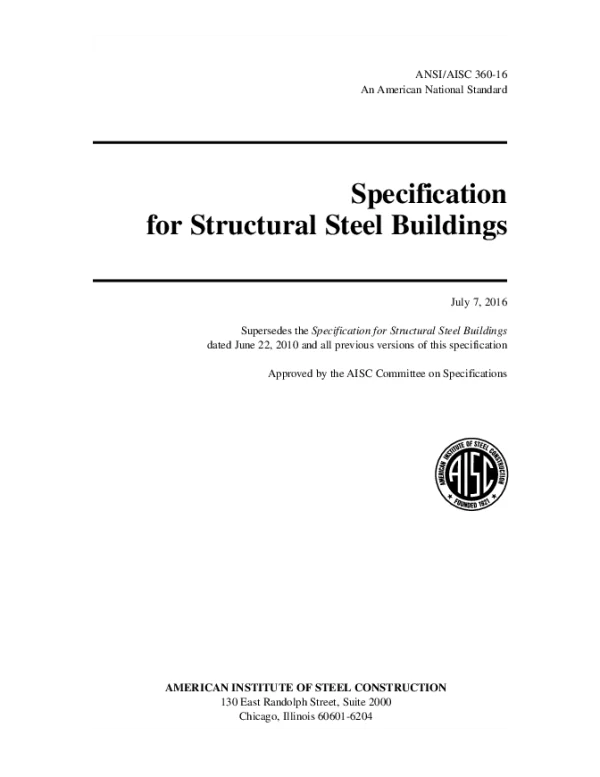-
资源简介
The AISC 360-16 Specification for Structural Steel Buildings is a critical document in the field of structural engineering, particularly for those working with steel structures. Published by the American Institute of Steel Construction (AISC), this specification provides comprehensive guidelines and standards for the design, fabrication, and erection of structural steel buildings. It serves as a reference for engineers, architects, and construction professionals to ensure that steel structures are safe, efficient, and compliant with national building codes.
One of the primary purposes of AISC 360-16 is to establish uniformity in the design and construction of steel buildings across the United States. By defining specific requirements for material properties, connection details, load combinations, and structural analysis methods, the specification helps to minimize the risk of structural failures and ensures that buildings can withstand various types of loads, including dead, live, wind, and seismic forces.
The document is structured into several chapters, each addressing different aspects of steel construction. These include general provisions, material specifications, design requirements for different types of structural elements such as beams, columns, and trusses, and detailed guidance on connections, bracing, and stability considerations. The specification also includes information on the use of high-strength bolts, welding procedures, and other critical factors that influence the performance of steel structures.
AISC 360-16 incorporates the latest research and technological advancements in steel construction. It reflects the evolving understanding of structural behavior under different loading conditions and includes updated formulas and methodologies for analysis and design. This ensures that the specification remains relevant and applicable to modern building practices.
Compared to previous versions of the AISC specification, AISC 360-16 introduces several improvements and clarifications. For example, it provides more detailed guidance on the design of moment frames, which are essential for resisting lateral loads such as wind and earthquakes. The specification also emphasizes the importance of considering the interaction between different structural components, ensuring that the overall system performs as intended.
In addition to technical content, AISC 360-16 includes references to other important standards and codes, such as the ASCE 7 Minimum Design Loads for Buildings and Other Structures. These references help users to integrate the steel design requirements with broader building code provisions, ensuring a cohesive and comprehensive approach to structural design.
The specification is widely used in the United States and is often referenced in building codes and regulatory frameworks. It is also recognized internationally, as many countries adopt similar principles for steel construction. Engineers and designers who follow AISC 360-16 can be confident that their designs meet the highest standards of safety and performance.
Furthermore, AISC 360-16 is accompanied by additional resources, such as commentary documents, examples, and software tools, which aid in the interpretation and application of the specification. These resources help professionals to better understand complex design concepts and apply them effectively in real-world projects.
Overall, AISC 360-16 plays a vital role in the construction industry by providing a reliable and up-to-date set of guidelines for the design and construction of steel buildings. Its comprehensive approach ensures that structures are not only safe and durable but also cost-effective and efficient. As the field of structural engineering continues to evolve, the AISC 360-16 specification will remain an essential tool for professionals committed to excellence in steel construction.
-
封面预览

-
下载说明
预览图若存在模糊、缺失、乱码、空白等现象,仅为图片呈现问题,不影响文档的下载及阅读体验。
当文档总页数显著少于常规篇幅时,建议审慎下载。
资源简介仅为单方陈述,其信息维度可能存在局限,供参考时需结合实际情况综合研判。
如遇下载中断、文件损坏或链接失效,可提交错误报告,客服将予以及时处理。